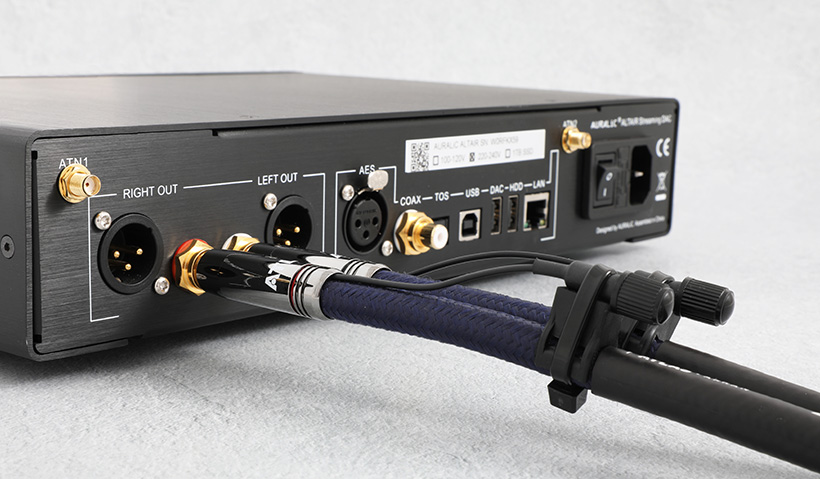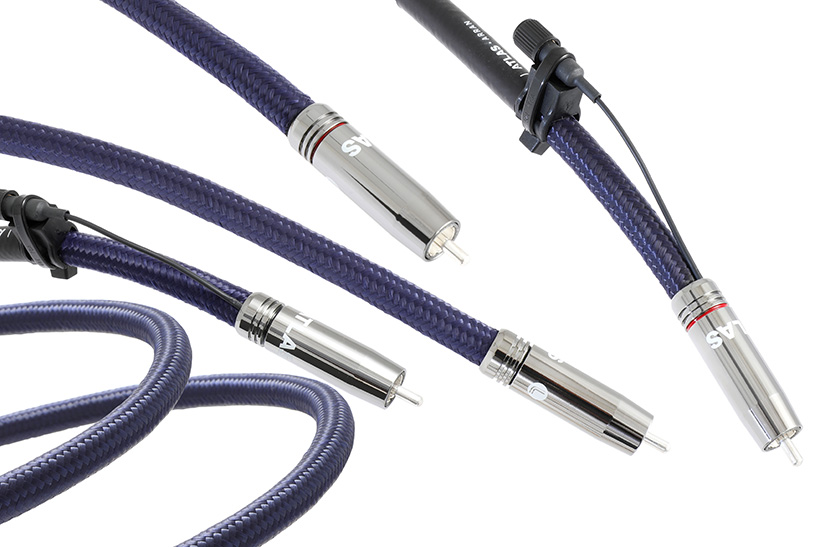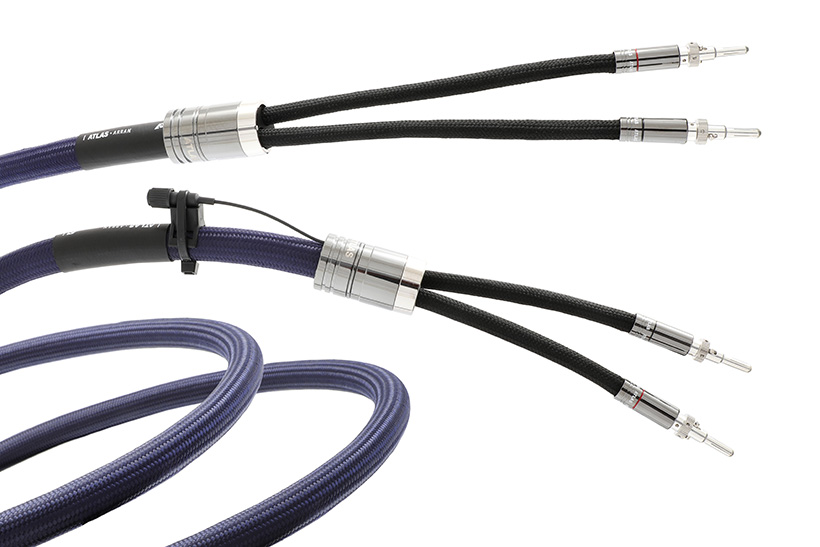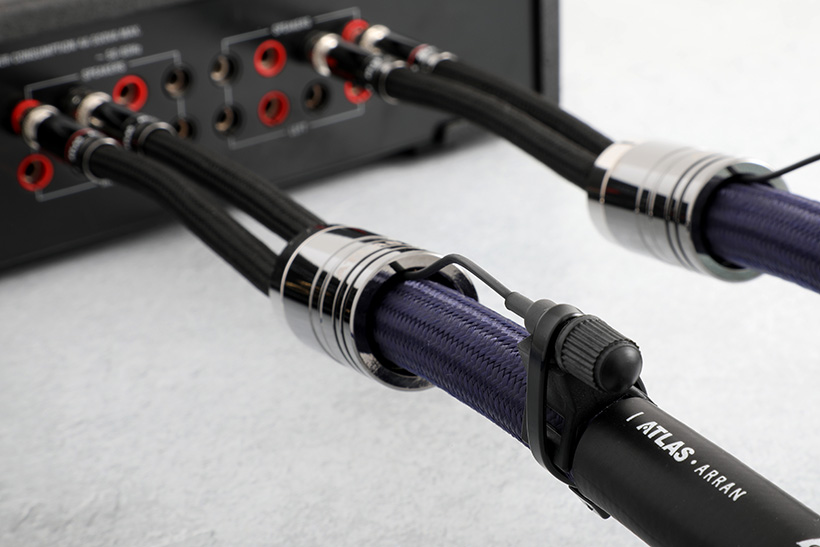Despite knowing about cable manufacturer Atlas for many years, I only recently discovered that they are based just 25 miles away from me in Kilmarnock. It’s always inspiring to read about British success stories but local ones are even better. Founder and MD Kevin Kelly’s engineering background means the Ayrshire enterprise is very much science-led; every product brought to market is not only thoroughly researched but also more often than not designed and built in-house from the ground up. Having complete control over its technologies and manufacturing processes gives the company the freedom and ability to define and meet its own exacting performance specifications.
One example of this is Atlas’ low-mass Transpose modular speaker termination system that not only minimises the amount of excess metal in the signal path but also allows customers to easily swap between 4mm expanding, spade, and Z-plugs as their requirements change. Another is their Grun coherent earthing system that provides an independent ground connection to minimise radio frequency (RF) and electromagnetic (EM) interference. The Scottish cable maker also differentiates itself from many of its competitors by eschewing silver-plated conductors and soldered terminations. It believes conductors made from either pure copper or silver deliver a more natural sound and that preserving the elongated crystal structure of these metals by ‘cold-welding’ or crimping them under calibrated pressure to achieve a gas-tight connection avoids another potentially significant source of signal degradation.

Atlas view every aspect of a cable’s construction as a possible source of lost fidelity and is continually looking for ways to improve the performance of the conductors, insulators, screens and terminations it uses. A new cable series has been in development for some time and was finally unveiled at this year’s High End Munich show. Arran bridges the performance gap between their Mavros and Asimi families and becomes Atlas’ premium OCC single crystal copper offering, a position Mavros held for more than a decade. It’s claimed to be their most transparent-sounding copper cable to date, “adding nothing to the sound characteristic of a system whilst offering significant screening and RF filtering that removes all unwanted background noise“.
The Atlas Arran Ultra L RCA Grun interconnect and Arran Transpose Grun speaker cable both use OCC copper conductors of 6N or 99.99997% purity that are solid-core to minimise inter-strand distortion. Six solid strands in the interconnect surround a seventh central wire and are tension-wrapped in a microporous PTFE (Teflon) dielectric. Noise is minimised by a double screen made from an OFC copper braid and copper-mylar film. Termination is via a new low-mass RCA connector called Ultra Latik, this plug apparently cleans itself upon insertion and removal and contains a 3D-printed polyethylene lattice insulating sleeve (below) with dielectric constant much closer to that of air to deliver a wider bandwidth and more natural sound. Available in single- (2-2) and bi- (2-4 and 4-4) wiring configurations, the six conductors used in the speaker cable are encased in a graduated dielectric that uses a helical cotton spiral to create an anti-vibration, air-spaced void near the cable’s surface and a microporous PFTE layer for stability. Noise is minimised by a double screen made from an OFC copper braid and aluminium-mylar film. Termination is via Atlas’ low-mass Transpose shell and screw-on plugs.

Atlas Grun
Both the Arran interconnects and speaker cables have flying leads at one end, these are connected via ‘dual drain’ wires to the cables’ screens and form Atlas’ Grun earthing system when they are grounded via the appropriate adapter. Two earthing configurations are possible with Grun, ‘pseudo-balanced’ and ‘independent’. The former grounds the cable to a spare input on the preamplifier via an RCA adapter, the latter grounds the cable to the earth tag on either the preamp or Atlas Eos Modular distribution block via a spade adapter. A Grun mains earthing plug supporting up to four connections is also available.
According to Atlas, connecting the flying leads to external ground (via Eos or Grun mains plug) is the most effective method of draining EMI and RFI from the system as it completely eliminates the modulation of circulating currents on the signal ground. There are, however, instances where grounding to a spare RCA input may be preferable, such as when there are double-insulated components with floating earths in the system. The team are more than happy to advise on this and encourage customers to get in touch if they have any questions – I can attest to Kevin Kelly’s knowledge and patience in addressing the barrage of queries I sent through.

The advantage of a clean, independent path to earth makes sense for high-impedance inputs as this is the easiest place for noise and interference can enter the system. Grounding loudspeaker cables is, however, not something that’s widely practised and when I asked Kevin about its benefits he explained to me that, while loudspeaker cables don’t typically pickup noise, they can broadcast it and this noise may potentially feed back into the system if it isn’t controlled. Grounding speaker cables can therefore apparently help to reduce the RF load on the system.
Set-up
Unboxing the Arran Ultra L RCA Grun interconnect and Arran Transpose Grun speaker cables when they arrived at my door was quite an experience. Each ships in a classy presentation box and I initially assumed these were oversized for effect but when I lifted the lids it became obvious why the boxes are as big as they are. Both cables are forces to be reckoned with, the speaker leads in particular are the meatiest I’ve encountered and their weight caught me off-guard as I struggled to lift them despite eating a full bowl porridge that morning! It’s sometimes difficult to see the value in high-end cables but Arran exudes an heirloom build quality. Its woven jacket can be upgraded upon request to Atlas’ Luxe hand-stitched leather for a more bespoke finish, though I must say the standard royal blue fabric is gorgeous.
Depending on system layout, wrestling these bad boys into position can be a challenge. Equipment that’s close to the wall may need to be pulled forward a few inches to accommodate their bend radiuses and, with amplifiers near the top of a rack or loudspeakers that are stand-mounted, it’s probably a good idea to support the weight of the speaker cable to minimise potential strain on the terminals when expanding or Z-plugs are used. Atlas’ Grun-equipped audio cables aren’t directional but connecting the ‘Grun end’ to the preamp makes for easier cable management, especially in systems wired with multiple Atlas cables. The manufacturer also recommends three days of burn-in on all of its cables to allow the dielectrics to become polarised in the direction of installation, after which time it’s claimed they reach optimal performance.

The Ultra L RCA interconnect was inserted, in turn, between a Schiit Yggdrasil OG D/A converter and Yamaha A-S3000 integrated and a Lyngdorf TDAi 3400 Class D integrated driving Celestion Ditton 66 floorstanders and Tannoy Autograph Mini standmounts. They were also tried with a Sparkos Labs Aries headphone amp partnered with Audio-Technica ATH-ADX5000 and Focal Utopia open-backs. The Transpose Grun speaker cables were auditioned alongside the interconnect in the first two systems. The flying Grun leads on all cables were externally grounded via an Atlas Grun mains plug.
Atlas Arran sound quality
Cables are often used as a tuning device to achieve a more desirable synergy between components in a system. While this approach can be very effective, deploying a cable to counter a perceived flaw or imbalance elsewhere implies that the cable itself is, for better or worse, also colouring the signal passing through it. After auditioning the Arran interconnects and loudspeaker cables in three different setups, it’s evident these products are aimed at purists already satisfied with the balance of their carefully curated components and in search of wiring that allows the true potential of their system to be heard with minimal loss of fidelity.
By refraining from imprinting a signature of their own onto the signal, I found it easier to discern and evaluate the presentational differences and synergies between amplifier and transducer pairings using these cables. It would, however, be wrong to infer from this that Arran is forensic tool better suited to the critiquing of components and recordings than the enjoyment of performances. If anything, I found the Atlas offerings more musically engaging than the reference cables they replaced. Leading edges no longer had a tendency to protrude in a manner that sounded slightly detached from the bodies of notes. Music was presented with more coherence and flow in each of three systems auditioned, this was especially noticeable when the Tannoys and Audio-Technicas were in rotation as both have exceptional transient responses and uber-revealing top ends.

To my relief, the smoother and rounder sound did not come at the expense of resolution. By driving down the noise floor, these cables allow you to hear deep into the recording with very fine granularity in the texture and decay structure of notes. On cymbal work in particular, there was a more natural balance between attack and release and the previous hint of splashiness was diminished. I also perceived a more open presentation; there was improved instrument separation, but not in an isolating way that draws artificial borders with ‘voids’ in between. Instead, I could more easily hear the low-level spatial cues captured in the recording and this enhanced the illusion of a walk-through soundstage formed by instruments being played together in three-dimensional space. The effect was subtle but noticeable nevertheless.
Atlas Arran verdict
I was very impressed by the ability of the Atlas Arran Ultra L RCA Grun interconnect and Transpose Grun loudspeaker cables to reveal the differing characteristics of the systems I used them with. Their effectiveness at getting out of the way of the music not only appears to demonstrate the importance of using the highest quality conductors and dielectrics to carry the audio signal but also the benefits of improved grounding to banish unwanted noise. Those serious about unlocking the full potential of their sound systems with transparent, natural-sounding cables owe Arran a listen.


